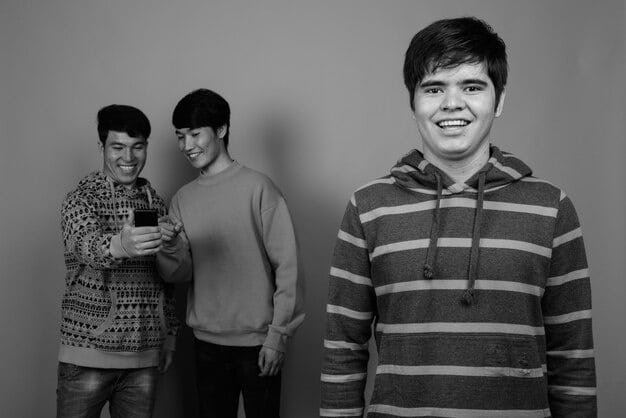Social Media’s Impact on Gen Z Attention & Educational Psychology Solutions

The pervasive influence of social media platforms profoundly impacts Gen Z’s attention spans, necessitating innovative educational psychology solutions to foster sustained learning and cognitive development in digital natives.
In an increasingly digital landscape, the attention spans of younger generations have become a topic of significant discourse, particularly concerning the profound influence of social media. This article delves into The Impact of Social Media on Gen Z’s Attention Span: Educational Psychology Solutions, exploring how these interconnected phenomena shape the cognitive habits of today’s students and what educational psychology offers as a roadmap for effective intervention.
understanding gen z’s digital ecosystem
Social media has become an inseparable part of Gen Z’s daily lives, shaping their communication, information consumption, and social interactions. This generation, born roughly between the mid-1990s and the early 2010s, are true digital natives, having grown up with the internet, smartphones, and social media platforms as ubiquitous tools. Their world is characterized by instant gratification, constant connectivity, and an abundance of information, all largely facilitated by popular platforms like TikTok, Instagram, and YouTube.
The inherent design of these platforms—short-form content, endless scrolling, constant notifications, and algorithmically curated feeds—trains the brain to expect rapid shifts in stimuli. This constant barrage of new information and the underlying reward system (likes, shares, comments) can potentially rewire neural pathways related to attention and focus. For Gen Z, this digital ecosystem is not merely a tool but a fundamental aspect of their lived experience, influencing everything from their leisure time to their academic pursuits. Educational psychologists are increasingly studying how these behaviors translate into academic settings, observing changes in how students engage with traditional learning materials and sustained tasks.
the allure of instantaneity
The primary appeal of social media lies in its instantaneity. Updates are real-time, interactions are immediate, and content is consumed in bite-sized pieces. This creates a psychological preference for quick returns and constant novelty.
- 🚀 Instant feedback loops reinforce quick engagement over deep thought.
- 🔄 Continuous novelty seeking can lead to difficulty sustaining interest in single tasks.
- ⏰ Short-form content trains the brain for rapid context switching.
social validation and dopamine hits
Beyond instant information, social media platforms are masters of social validation. Likes, comments, and shares provide intermittent rewards, triggering dopamine releases in the brain. This creates a powerful feedback loop, driving users to check their devices frequently and seek out more validation. The anticipation of this reward can be distracting, pulling attention away from other, less immediately gratifying activities. This constant search for external validation can diminish intrinsic motivation for activities that require sustained effort without immediate social recognition.
The transition from a world of delayed gratification to one of instant digital rewards presents a significant challenge for educators. Traditional learning often involves painstaking effort, critical analysis, and a delayed sense of accomplishment. Understanding this fundamental shift in motivation is crucial for developing effective educational strategies.
In summary, Gen Z’s digital ecosystem is a complex web of instant information, social validation, and carefully designed addictive features. While these elements offer connectivity and access to information, they also pose significant challenges to the development of sustained attention and deep cognitive processing, areas critical for academic success and lifelong learning. Recognising this unique environment is the first step toward crafting meaningful educational psychology solutions.
identifying attention span challenges in gen z
The pervasive use of social media among Gen Z has led to noticeable shifts in their cognitive habits, particularly concerning attention. While some argue that Gen Z has adapted to a new form of “multi-attention,” educational psychologists and researchers increasingly point to potential deficits in sustained, deep focus. This section explores the specific ways social media use manifests as attention span challenges within this demographic, drawing parallels to observable behaviors in academic and daily settings.
One of the most evident challenges is the increased propensity for task switching. Many Gen Z individuals report constantly toggling between various applications, websites, and content formats, even when engaged in specific tasks like studying. This rapid switching, often driven by notifications or the urge to check social feeds, fragments attention and inhibits the ability to concentrate deeply on a single subject for extended periods. This multitasking, often termed “media multitasking,” has been shown in studies to decrease comprehension and increase the time needed to complete tasks.
Additionally, the preference for short-form content fostered by platforms like TikTok and Instagram Reels cultivates an expectation of rapid information delivery and frequent novelty. When confronted with longer texts, lectures, or complex problem-solving requiring sustained engagement, Gen Z students may struggle to maintain interest and focus. This can manifest as increased boredom, fidgeting, or a tendency to seek out distractions when faced with less stimulating, but fundamentally important, academic content.
the struggle with sustained engagement
Traditional learning often requires prolonged periods of focused attention on a single subject. This can be particularly challenging for Gen Z due to their digital upbringing.
- 📖 Difficulty with reading lengthy texts or articles without frequent breaks.
- 👨🏫 Reduced ability to focus during long lectures or presentations.
- 💡 A tendency to skim information rather than engage in deep, critical analysis.
This struggle is not necessarily a lack of intelligence, but rather a re-patterning of attentional habits. The brain, accustomed to constant stimulation, finds sustained, monotonous tasks less rewarding.
impact on academic performance
The consequences of these attention span shifts are evident in academic environments. Students may find it harder to absorb complex information, retain details, and perform well on tasks requiring sustained cognitive effort.
Consider the example of preparing for an exam. While previous generations might have spent hours in focused study, Gen Z students might break up their study sessions with frequent social media checks, which can disrupt their cognitive flow and hinder memory consolidation. This fragmented approach often leads to superficial learning rather than deep understanding. Educators often report observing students struggling with extended problem-solving tasks, requiring sequential thought and persistence over immediate answers.
In conclusion, the attention span challenges observed in Gen Z as a result of social media engagement are multifaceted. They range from an increased tendency for task switching and a diminished capacity for sustained focus to a preference for short-form, rapidly changing content. These challenges directly impact academic performance and highlight the urgent need for educational psychology to intervene with tailored solutions that acknowledge and address this evolving cognitive landscape.
educational psychology’s role in intervention
Educational psychology, a branch of psychology that deals with the study of how humans learn in educational settings, plays a pivotal role in addressing the challenges posed by social media on Gen Z’s attention spans. It moves beyond merely identifying the problem to developing and implementing evidence-based solutions. Educational psychologists are uniquely positioned to bridge the gap between cognitive science, technological trends, and practical classroom strategies, focusing on how teaching methodologies can adapt to the evolving minds of digital natives.
Their role begins with in-depth research to understand the precise mechanisms through which social media influences attention, memory, and learning. This includes studying patterns of device usage, the neurocognitive effects of constant stimulation, and the impact on various learning styles. Based on these findings, educational psychologists design interventions that aim to strengthen attention regulation, foster deeper cognitive processing, and cultivate a healthier relationship with digital tools. This often involves collaborating with educators, parents, and even technology developers to create a more conducive learning environment.
One key aspect of their intervention involves promoting metacognitive awareness among students. By helping Gen Z understand how their own attention works and how digital habits can either enhance or hinder it, they gain agency over their learning processes. This empowers them to make conscious choices about when and how to engage with digital devices, rather than passively falling prey to their allure. Furthermore, educational psychology emphasizes adapting teaching methods to integrate technology judiciously, transforming it from a potential distraction into a valuable learning asset.
re-framing digital literacy
Beyond simple technological proficiency, educational psychology advocates for a deeper form of digital literacy. This involves teaching students how to critically evaluate information, understand the persuasive design of social media platforms, and develop self-regulation skills in a digital environment.
- 💡 Educating students on the neuroscience of attention and device usage.
- 🔍 Fostering critical thinking skills to navigate online information.
- 🌐 Promoting responsible digital citizenship and online well-being.
This approach goes beyond just “using” technology; it focuses on understanding its impact on one’s own cognition.
designing attentional training programs
Educational psychologists are also at the forefront of developing specific programs aimed at retraining and strengthening attention. These often involve techniques borrowed from mindfulness, cognitive behavioral therapy, and neurocognitive science.
These programs might integrate short bursts of focused work with planned breaks, or introduce activities that build sustained attention incrementally. For instance, activities that require students to focus on a single, non-stimulating task for increasing durations can slowly rebuild their capacity for deep concentration. The goal is not to eliminate digital interaction but to balance it with traditional forms of learning that cultivate sustained cognitive engagement.
In essence, educational psychology’s role extends from foundational research to practical, implementable strategies. By understanding the unique cognitive landscape of Gen Z and the pervasive influence of social media, it provides the principles and techniques necessary to equip students with the attentional skills required to thrive in a complex, digital-first world. The focus is on empowerment, adaptation, and fostering a healthier, more effective learning experience.

strategies for educators: fostering focused learning
Equipping educators with effective strategies is paramount in addressing the attention span challenges of Gen Z. Educational psychology provides a robust framework for developing pedagogical approaches that acknowledge students’ digital habits while simultaneously cultivating deeper levels of sustained focus. These strategies are not about eliminating technology, but rather about integrating it thoughtfully and designing learning experiences that build attentional resilience.
One key strategy involves incorporating structured breaks and purposeful digital detox moments within the learning day. Recognizing that Gen Z is accustomed to rapid shifts, short, focused work periods followed by brief, scheduled breaks can be more effective than expecting prolonged, unbroken concentration. Educators can use these breaks to encourage physical movement or mindful activities, allowing students’ minds to reset before returning to focused tasks. This approach acknowledges the current reality of attention spans while gradually extending their capacity.
Another crucial strategy is the intentional design of engaging and interactive learning activities. While social media provides constant novelty, learning environments can also be made more dynamic. This means moving beyond passive lectures and incorporating more project-based learning, collaborative tasks, and problems that require critical thinking. When students are actively involved in constructing knowledge, they are more likely to stay engaged and maintain focus, even on complex topics. The emphasis shifts from simply delivering information to facilitating discovery and application.
implementing the “attention diet”
Just as one manages a food diet, an “attention diet” involves mindful consumption of digital content. Educators can guide students in making conscious choices about their screen time and the types of content they engage with.
- 📵 Designate “no-phone zones” or specific periods for focused work without digital devices.
- ⏱️ Utilize the Pomodoro Technique (25 minutes focused work, 5 minutes break) or similar time management strategies.
- 🧩 Assign tasks that require deep concentration and discourage multitasking.
This nurtures self-discipline and teaches students to manage their cognitive resources.
diversifying instructional methods
Relying solely on traditional lectures can quickly lose the attention of a generation accustomed to dynamic visual and interactive content. Educators must diversify their instructional toolkit. This could include:
* **Gamification:** Incorporating game-like elements into learning tasks to increase engagement and motivation.
* **Visual learning:** Utilizing infographics, interactive simulations, and short, high-quality educational videos to complement text-based materials.
* **Active learning:** Encouraging group discussions, debates, peer teaching, and creative projects that demand active participation.
By blending various methods, educators can cater to different learning preferences and keep students actively involved, thereby naturally extending their attention spans. The goal is to make learning inherently engaging, reducing the need for external distractions.
In conclusion, fostering focused learning for Gen Z requires a proactive and adaptable approach from educators. By implementing strategies like structured breaks, designing engaging activities, promoting an “attention diet,” and diversifying instructional methods, schools can create environments that not only account for the challenges of social media but also empower students to strengthen their attentional capabilities for lifelong success.
parental involvement: building digital resilience at home
The role of parents is undeniably critical in navigating the impact of social media on Gen Z’s attention spans. While schools implement strategies, the home environment often dictates a significant portion of a child’s digital exposure and habits. Educational psychology emphasizes that fostering digital resilience is a shared responsibility, requiring consistent effort and understanding from both parents and educators. Effective parental involvement goes beyond simply limiting screen time; it involves establishing healthy digital habits, open communication, and modeling responsible technology use.
One of the most impactful ways parents can contribute is by creating a structured home environment that promotes balanced digital engagement. This includes setting clear rules around device usage, identifying “tech-free” zones (like dining tables or bedrooms before sleep), and designating specific times for homework or family activities that are uninterrupted by screens. Consistency in these routines helps children internalize boundaries and reduces the impulsive checking of devices that can fragment attention. Moreover, encouraging offline hobbies and activities—such as reading physical books, engaging in sports, or creative arts—provides valuable alternatives to constant digital stimulation, helping to diversify their attentional focus.
Beyond rules, open and honest communication about social media’s effects is paramount. Parents should engage their children in discussions about the psychological impact of platforms, including how algorithms work, the nature of online validation, and the potential for distraction. This empowers Gen Z to become more critical consumers of digital content rather than passive recipients. Modeling responsible digital behavior themselves is equally important; children learn much by observing their parents’ habits with smartphones and other devices. These actions collectively build a foundation for digital resilience, allowing children to harness the benefits of technology while mitigating its potential drawbacks.
setting digital boundaries and routines
Establishing clear, consistent boundaries around device use is foundational. This helps children develop self-regulation and reduces the constant pull of notifications.
- 🚫 Implement “no-phone” times during meals, family gatherings, or study periods.
- 🛌 Encourage device-free bedrooms, especially before bedtime to improve sleep quality.
- 📝 Co-create a family media plan that outlines screen time limits and digital responsibilities.
encouraging offline activities and hobbies
Diversifying exposure beyond screens is vital for developing a well-rounded attention span. Offline activities engage different cognitive and sensory pathways.
Consider encouraging hobbies like:
* Reading physical books, which require sustained focus and imagination.
* Engaging in sports or outdoor play, promoting physical activity and situational awareness.
* Creative pursuits like painting, playing musical instruments, or building models, which foster concentration and problem-solving.
These activities naturally train sustained attention and provide a healthy counterbalance to the fast-paced, multi-sensory world of social media. They also encourage a sense of delayed gratification, as mastery often comes after sustained effort.
In conclusion, parental involvement is a cornerstone of building digital resilience and managing the impact of social media on Gen Z’s attention. By setting clear boundaries, fostering open communication, and actively promoting engaging offline activities, parents can create a home environment that cultivates sustained focus and helps their children thrive in an increasingly digital world. This integrated approach, supported by educational psychology principles, is key to empowering the next generation.
interventions at the policy and platform level
Addressing the complex issue of social media’s impact on Gen Z’s attention spans requires more than just individual or educational interventions; it also necessitates action at the policy and platform level. Educational psychology, with its understanding of human behavior and learning, can inform decision-makers in developing regulations and designing digital environments that are more conducive to healthy cognitive development. This involves advocating for responsible design, increased transparency, and features that support focus rather than eroding it.
Policy interventions might focus on stricter regulations regarding the persuasive design elements employed by social media companies. This could include limitations on constant notifications, “infinite scroll” features, or algorithmic recommendations that prioritize engagement over user well-being. Governments and regulatory bodies, informed by research from educational psychologists, could develop guidelines or even mandates that push platforms to incorporate features promoting self-regulation and mindful use. For instance, requiring platforms to include built-in “time-out” reminders or summary reports on usage could empower users to make more informed choices about their screen time.
At the platform level, there’s a growing call for social media companies themselves to adopt ethical design principles. This means moving beyond optimizing solely for engagement and instead considering the cognitive and psychological well-being of their users, particularly younger demographics. Educational psychologists can collaborate with tech companies to design features that support focused consumption, offer customizable notification settings, or even provide tools for digital well-being that are less addictive and more supportive of sustained attention. The goal is to shift from a purely attention-economy model to one that fosters a healthier digital ecosystem for Gen Z.
advocating for ethical design principles
Educational psychology can contribute to the discussion around ethical design in technology, pushing for platforms that prioritize user well-being over solely profit-driven engagement metrics.
- 🚫 Campaign against features designed to be overly addictive or attention-holding.
- 📊 Advocate for transparency regarding the psychological effects of platform algorithms.
- 💡 Encourage “attention-friendly” design choices, such as customizable notification settings and usage dashboards.
This proactive stance aims to shape the digital environment itself.
research and collaboration with tech companies
A crucial step is for educational psychologists to engage directly with technology companies and policymakers. This collaboration can involve:
* **Conducting joint research:** Studying the long-term cognitive and behavioral impacts of specific platform features.
* **Providing expert consultation:** Offering insights on how design choices affect attention span and learning.
* **Developing new tools:** Creating in-app features (e.g., focus modes, digital well-being reminders) that help users manage their attention more effectively.
This cross-disciplinary approach recognizes that the problem is systemic and requires solutions that extend beyond the individual user or classroom. By influencing policy and design, educational psychology seeks to create a digital landscape that supports, rather than undermines, sustained attention in Gen Z. Ultimately, this ensures that the tools meant to connect and inform do not inadvertently hinder fundamental cognitive development.
the long-term outlook: fostering lifelong attention skills
The evolving landscape of social media and its discernible impact on Gen Z’s attention spans is not merely a contemporary challenge but a long-term societal concern. Educational psychology, therefore, must focus not only on immediate interventions but also on fostering lifelong attention skills that will empower this generation and future ones to thrive in an increasingly digital and information-rich world. The goal extends beyond mitigating current negative effects; it aims to cultivate cognitive resilience and adaptability, ensuring individuals can maintain focus and engage deeply with complex information throughout their lives, regardless of technological advancements.
This long-term outlook emphasizes the development of metacognitive abilities—the capacity to think about one’s own thinking. By understanding how their attention works, recognizing personal triggers for distraction, and knowing strategies to regain focus, Gen Z can become self-regulated learners. This involves teaching them to be aware of their “attention budget” and to make conscious choices about how they allocate their cognitive resources. It’s about empowering them with the tools to manage their internal and external distractions, rather than simply being reactive to them. Educational psychology can integrate these lessons into curricula from an early age, making attention management a core life skill.
Furthermore, fostering lifelong attention skills involves promoting a balanced relationship with technology. This doesn’t mean becoming tech-averse, but rather tech-savvy and mindful. It encompasses understanding when and how technology enhances learning and when it serves as a distraction. It also involves cultivating an appreciation for activities that require sustained, deep engagement, such as reading complex texts, engaging in extended problem-solving, or pursuing creative endeavors that demand patience and persistence. By instilling these values, educational psychology can help Gen Z navigate not only current digital challenges but also those that will inevitably emerge in the future.
integrating attention training into curricula
Attention training should not be an add-on but an integral part of educational curricula from early childhood through higher education.
- 🧘 Incorporate mindfulness exercises and focused breathing techniques into daily routines.
- 🗣️ Teach explicit strategies for managing distractions and maintaining concentration during tasks.
- 🧠 Design learning activities that progressively increase the demand for sustained attention.
This systemic integration builds foundational attention skills over time.
promoting media literacy and discernment
A critical lifelong skill in the digital age is the ability to critically evaluate media and discern credible information from noise. This goes hand-in-hand with attention management.
Consider teaching students how to:
* Identify manipulative design features in social media that aim to capture their attention.
* Evaluate sources for bias and accuracy, requiring sustained attention to detail.
* Understand the difference between surface-level information consumption and deep learning.
These skills empower individuals to be active, discerning consumers of information rather than passive recipients of an endless digital feed. They foster a critical mindset that supports focused engagement with meaningful content.
In conclusion, the long-term outlook within educational psychology goes beyond immediate fixes, aiming to equip Gen Z with robust, adaptable attention skills for a lifetime. By integrating attention training into curricula and promoting sophisticated media literacy, education can prepare this generation to not only manage the challenges of social media but also to confidently navigate the complexities of an ever-evolving digital world, fostering deep learning and cognitive well-being.
| Key Point | Brief Description |
|---|---|
| 📱 Digital Ecosystem Impact | Social media’s instantaneity and reward systems reshape Gen Z’s attention habits. |
| 🧠 Attention Span Challenges | Students face difficulties with sustained focus due to constant task switching and short-form content preference. |
| 📚 Educational Psychology Solutions | Offers strategies like metacognitive training, “attention diets,” and diversified instruction. |
| 🤝 Collaborative Approach | Effective intervention requires involvement from educators, parents, and policy-makers to create a balanced digital environment. |

frequently asked questions about social media and gen z attention
Social media platforms significantly impact Gen Z’s attention by fostering a preference for instant gratification and constant novelty. Features like endless scrolling, short-form content, and continuous notifications train the brain for rapid context switching, making sustained focus on single tasks more challenging. This can lead to increased impulsivity and difficulty engaging with longer, less dynamic information, directly affecting their ability to concentrate for extended periods.
In this context, digital literacy extends beyond simply knowing how to use technology. It involves teaching Gen Z to critically evaluate online information, understand the persuasive design elements of social media, and develop strong self-regulation skills in a digital environment. It empowers them to make conscious choices about their screen time and engagement, moving from passive consumption to active, discerning digital citizenship, which in turn helps manage their attention.
Yes, educational psychology offers evidence-based strategies to help students strengthen their attention capacity. This includes implementing “attention diets” with structured device breaks, diversifying instructional methods to engage students more deeply, and introducing metacognitive training. These interventions build attentional stamina gradually, retraining the brain for sustained focus and critical thinking, rather than solely reacting to constant external stimuli.
Parents play a crucial role by establishing healthy digital boundaries and routines at home, such as designated “tech-free” zones and times. Encouraging diverse offline activities like reading, sports, or creative hobbies provides alternatives to screen time and naturally fosters sustained attention. Open communication about social media’s effects and modeling responsible digital behavior also empower children to develop digital resilience and self-manage their attention.
Yes, broader policy solutions informed by educational psychology findings can address this challenge. This includes advocating for ethical design principles in social media platforms that prioritize user well-being over engagement. Regulations might target addictive features like endless scrolls or excessive notifications. Collaboration between educational psychologists and tech companies can also lead to the development of in-app tools that promote mindful usage and help users manage their screen time effectively.
conclusion
The interplay between social media and Gen Z’s attention span represents a significant challenge for contemporary education and mental well-being. This article has explored the profound shifts in cognitive habits driven by ubiquitous digital platforms and outlined a comprehensive suite of educational psychology solutions. From adapting classroom strategies and fostering parental involvement to advocating for responsible platform design and broader policy changes, a multi-faceted approach is essential. By understanding the unique digital native landscape and proactively implementing evidence-based interventions, we can empower Gen Z to navigate the complexities of the digital world, cultivate sustained attention, and unlock their full learning potential. The ultimate goal is not to eliminate technology, but to cultivate a balanced relationship that harnesses its benefits while safeguarding the foundational cognitive skills crucial for lifelong success.





